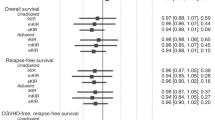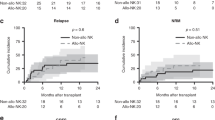Abstract
Killer cell immunoglobulin-like receptors (KIRs) recognize different groups of Human Leukocyte Antigen (HLA) class I alleles and are expressed by natural killer (NK) cells and some T lymphocytes. NK cell cytotoxicity is triggered by failure to recognize the appropriate HLA class I ligand on target cells. Recently, it has been shown that HLA class I ligand incompatibility in the graft-versus-host (GvH) direction is associated with a better outcome in haploidentical hematopoietic stem cell transplantation (HSCT). Since KIR genotypes are very diverse in the population, we explored whether or not the donor KIR genotype could affect the graft-versus-leukemia (GvL) effect in the related HLA-identical HSCT setting. We determined the KIR and HLA genotypes of 65 HLA-identical patient–donor siblings. We found that the presence of two activating KIRs, 2DS1 and 2DS2, in the donor was significantly associated with a decreased leukemic relapse rate (P=0.03; OR=0.18; 95% CI: 0.037–0.88). Moreover, the probability of relapse at 5 years was significantly lower for patients who received a graft from a donor with the 2DS1(+)2DS2(+) genotype than for those who received a transplant from other donors (17 vs 63%, respectively; P=0.018). In conclusion, this study suggests that a joint effect of these two selected activating KIRs in the donor might confer some protection against leukemic relapse.
This is a preview of subscription content, access via your institution
Access options
Subscribe to this journal
Receive 12 print issues and online access
$259.00 per year
only $21.58 per issue
Buy this article
- Purchase on Springer Link
- Instant access to full article PDF
Prices may be subject to local taxes which are calculated during checkout


Similar content being viewed by others
References
Miller JS . The biology of natural killer cells in cancer, infection, and pregnancy. Exp Hematol 2001; 29: 1157–1168.
Biassoni R, Cantoni C, Pende D, Sivori S, Parolini S, Vitale M et al. Human natural killer cell receptors and co-receptors. Immunol Rev 2001; 181: 203–214.
Farag SS, Fehniger T, Ruggeri L, Velardi A, Caligiuri MA . Natural killer cell receptors: new biology and insights into the graft-versus-leukemia effect. Blood 2002; 100: 1935–1947.
Natarajan K, Dimasi N, Wang J, Mariuzza R, Margulies DH . Structure and function of natural killer cell receptors: Multiple molecular solutions to self, nonself discrimination. Annu Rev Immunol 2002; 20: 853–885.
Colonna M, Brooks EG, Falco M, Ferrara GB, Strominger JL . Generation of allospecific natural killer cells by stimulation across a polymorphism of HLA-C. Science 1993; 260: 1121–1124.
Moretta A, Vitale M, Bottino C, Orengo AM, Morelli L, Augugliaro R et al. P58 molecules as putative receptors for major histocompatibility complex (MHC) class I molecules in human natural killer (NK) cells: anti-P58 antibodies reconstitute lysis of MHC class I-protected cells in NK clones displaying different specificities. J Exp Med 1993; 178: 597–604.
Gumperz JE, Litwin V, Phillips JH, Lanier LL, Parham P . The Bw4 public epitope of HLA-B molecules confers reactivity with NK cell clones that express NKB1, a putative HLA receptor. J Exp Med 1995; 181: 1133–1144.
Döhring C, Scheidegger D, Samaridis J, Cella M, Colonna M . A human killer inhibitory receptor specific for HLA-A. J Immunol 1996; 156: 3098–3101.
Valés-Gomez M, Reyburn HT, Erskine RA, Strominger J . Differential binding to HLA-C of p50-activating and p58-inhibitory natural killer cell receptors. Proc Natl Acad Sci USA 1998; 95: 14326–14331.
Moretta A, Sivori S, Vitale M, Pende D, Morelli L, Augugliaro R et al. Existence of both inhibitory (p58) and activating (p50) receptors for HLA-C molecules in human natural killer cells. J Exp Med 1995; 182: 875–884.
Biassoni R, Cantoni C, Falco M, Verdiani S, Bottino C, Vitale M et al. The human leucocyte antigen (HLA)-C-specific ‘activating’ or ‘inhibitory’ natural killer cell receptors display highly homologous extracellular domains but differ in their transmembrane and intracytoplasmic portions. J Exp Med 1996; 183: 645–650.
Valés-Gomez M, Reyburn HT, Mandelboim M, Strominger J . Kinetics of interaction of HLA-ligands with natural killer cell inhibitory receptors. Immunity 1998; 9: 337–344.
Smith HR, Heusel JW, Mehta IK, Kim S, Dorner BG, Naidenko OV et al. Recognition of a virus-encoded ligand by a natural killer cell activation receptor. Proc Natl Acad Sci USA 2002; 99: 8826–8831.
Arase H, Mocarski ES, Campbell AE, Hill AB, Lanier LL . Direct recognition of cytomegalovirus by activating and inhibitory NK cell receptors. Science 2002; 296: 1323–1326.
Katz G, Gazit R, Arnon TI, Gonen-Gross T, Tarcic G, Markel G et al. MHC class I-independent recognition of NK-activating receptor KIR2DS4. J Immunol 2004; 173: 1819–1825.
Uhrberg M, Valiante NM, Shum BP . Human diversity in killer cell inhibitory receptor genes. Immunity 1997; 7: 753–763.
Witt CS, Dewing C, Sayer DC, Uhrberg M, Parham P, Christiansen FT . Population frequencies and putative haplotypes of the killer cell immunoglobuline-like receptor sequences and evidence for recombination. Transplantation 1999; 68: 1784–1789.
Shilling HG, Guethlein LA, Cheng NW, Gardiner CM, Rodriguez R, Parham P . Allelic polymorphism synergizes with variable gene content to individualize human KIR genotype. J Immunol 2002; 168: 2307–2315.
Ljunggren HG, Karre K . In search of the missing self: MHC molecules and NK cell recognition. Immunol Today 1990; 11: 237–244.
Algarra I, Cabrera T, Garrido F . The HLA crossroad in tumor immunology. Hum Immunol 2000; 61: 65–73.
Elkins WL, Pickard A, Pierson GR . Deficient expression of class-I HLA in some cases of acute leukemia. Cancer Immunol Immunother 1984; 18: 91–100.
Brouwer RE, van der Heiden P, Schreuder GM, Mulder A, Datema G, Anholts JD et al. Loss or downregulation of HLA class I expression at the allelic level in acute leukemia is infrequent but functionally relevant, and can be restored by interferon. Hum Immunol 2002; 63: 200–210.
Demanet C, Mulder A, Deneys V, Worsham MJ, Claas FH, Ferrone S . Down-regulation of HLA-A and HLA-Bw6, but not HLA-Bw4, allospecificities in leukemic cells: an escape mechanism from CTL and NK attack? Blood 2004; 103: 3122–3130.
Ruggeri L, Capanni M, Martelli MF, Velardi A . Cellular therapy: exploiting NK cell alloreactivity in transplantation. Curr Opin Immunol 2001; 8: 355–359.
Ruggeri L, Capanni M, Urbani E, Perruccio K, Shlomchik WD, Tosti A et al. Effectiveness of donor natural killer cell alloreactivity in mismatched hematopoietic transplants. Science 2002; 295: 2097–2101.
Bishara A, Amar A, Brautbar C, Condiotti R, Lazarovitz V, Nagler A . The putative role of HLA-C recognition in graft versus host disease (GVHD) and graft rejection after unrelated bone marrow transplantation (BMT). Exp Hematol 1995; 23: 1667–1675.
Giebel S, Locatelli F, Lamparelli T, Velardi A, Davies S, Frumento G et al. Survival advantage with KIR ligand incompatibility in hematopoietic stem cell transplantation from unrelated donors. Blood 2003; 102: 814–819.
Verheyden S, Bernier M, Demanet C . Identification of natural killer cell receptor phenotypes associated with leukemia. Leukemia 2004; 18: 2002–2007.
Maxwell LD, Williams F, Gilmore P, Meenagh A, Middleton D . Investigation of killer cell immunoglobulin-like receptor gene diversity: II. KIR2DS4. Hum Immunol 2004; 65: 613–621.
Martin MP, Gao X, Lee JH, Nelson GW, Detels R, Goedert JJ et al. Epistatic interaction between KIR3DS1 and HLA-B delays the progression to AIDS. Nat Genet 2002; 31: 429–434.
Nelson GW, Martin MP, Gladman D, Wade J, Trowsdale J, Carrington M . Cutting edge: heterozygote advantage in autoimmune disease: hierarchy of protection/susceptibility conferred by HLA and killer Ig-like receptor combinations in psoriatic arthritis. J Immunol 2004; 173: 4273–4276.
Cook MA, Milligan DW, Fegan CD, Darbyshire PJ, Mahendra P, Craddock CF et al. The impact of donor KIR and patient HLA-C genotypes on outcome following HLA-identical sibling hematopoietic stem cell transplantation for myeloid leukemia. Blood 2004; 103: 1521–1526.
Davies SM, Ruggieri L, DeFor T, Wagner JE, Weisdorf DJ, Miller JS et al. Evaluation of KIR ligand incompatibility in mismatched unrelated donor hematopoietic transplants. Blood 2002; 100: 3825–3827.
Bishara A, De Santis D, Witt CC, Brautbar C, Christiansen FT, Or R et al. The beneficial role of inhibitory KIR genes of HLA class I NK epitopes in haploidentically mismatched stem cell allografts may be masked by residual donor-alloreactive T cells causing GVHD. Tissue Antigens 2004; 63: 204–211.
Bornhauser M, Schwerdtfeger R, Martin H, Frank KH, Theuser C, Ehninger G . Role of KIR ligand incompatibility in hematopoietic stem cell transplantation using unrelated donors. Blood 2004; 103: 2860–2862.
Gardiner CM, Guethlein LA, Shilling HG, Pando M, Carr WH, Rajalingam R et al. Different NK cell surface phenotypes defined by the DX9 antibody are due to KIR3DL1 gene polymorphism. J Immunol 2001; 166: 2992–3001.
Acknowledgements
We thank A Willekens and her nursing staff from the HSC Transplant Intensive Care Unit for the excellent care of the patients and clinical data collection. We also thank B Guns for editing the manuscript. We are grateful to Dr Y Van Riet and Dr S Sumbwanyambe for a critical review of the manuscript. This work was supported by a grant from the Scientific Fund W Gepts AZ-VUB.
Author information
Authors and Affiliations
Corresponding author
Rights and permissions
About this article
Cite this article
Verheyden, S., Schots, R., Duquet, W. et al. A defined donor activating natural killer cell receptor genotype protects against leukemic relapse after related HLA-identical hematopoietic stem cell transplantation. Leukemia 19, 1446–1451 (2005). https://doi.org/10.1038/sj.leu.2403839
Received:
Accepted:
Published:
Issue Date:
DOI: https://doi.org/10.1038/sj.leu.2403839
Keywords
This article is cited by
-
Natural killer cells in antitumour adoptive cell immunotherapy
Nature Reviews Cancer (2022)
-
Increased donor inhibitory KIR with known HLA interactions provide protection from relapse following HLA matched unrelated donor HCT for AML
Bone Marrow Transplantation (2021)
-
Donor-recipient killer immunoglobulin like receptor (KIR) genotype matching has a protective effect on chronic graft versus host disease and relapse incidence following HLA-identical sibling hematopoietic stem cell transplantation
Annals of Hematology (2018)
-
NK cell therapy for hematologic malignancies
International Journal of Hematology (2018)
-
Partial break in tolerance of NKG2A−/LIR-1− single KIR+ NK cells early in the course of HLA-matched, KIR-mismatched hematopoietic cell transplantation
Bone Marrow Transplantation (2017)



